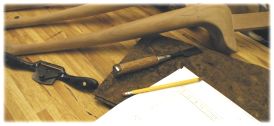|
The Basic DIY Vacuum Jig
Parts List
Vacuum Jig Material
A jig/template can be made from any ¾" thick or thicker. It is important to use non-porous material for the jigs. I've tried cherry and maple lumber for the jigs but was unable to get it to hold a vacuum unless it's given a thick coat of polyurethane. Plywood doesn't work well either (unless it is Baltic birch).
Then I came across a plastic called HDPE (high density polyethylene) and I was thrilled because this material works incredibly well. Here's why:
- It's non-porous and flat.
- It can be machined with woodworking tools easily.
- Vacuum sealing tape sticks to it very well but it's also easy to remove.
Getting Started
Vacuum clamping jigs can be made in any size needed. A clamping jig that is 6" x 12" can be very useful. In fact, two of these jigs will clamp almost anything you can put on your workbench. I'll explain how in a moment.
 To make the hold-down jig operational, you have to create a simple air channeling system to direct the vacuum to the work-piece and optionally, to your workbench. For ¾" thick jig material, a 1/8"NPT brass barb fitting works perfectly because it's small enough to prevent the edges of the jig from cracking. A 11/32" drill bit will give you just about the right opening to thread in the brass barb. Select which side of the jig is most convenient for the vacuum tube connection and drill a hole ½" deep. Then use a 3/16" diameter drill bit to make the same hole 2" deeper. Be sure to plunge the bit in straight (this is critical). We'll call this the air channel. To make the hold-down jig operational, you have to create a simple air channeling system to direct the vacuum to the work-piece and optionally, to your workbench. For ¾" thick jig material, a 1/8"NPT brass barb fitting works perfectly because it's small enough to prevent the edges of the jig from cracking. A 11/32" drill bit will give you just about the right opening to thread in the brass barb. Select which side of the jig is most convenient for the vacuum tube connection and drill a hole ½" deep. Then use a 3/16" diameter drill bit to make the same hole 2" deeper. Be sure to plunge the bit in straight (this is critical). We'll call this the air channel.
Now carefully measure to the end of the air channel and drill from the face side of the jig into the air channel. Do not drill all the way through the jig yet! Here's why… If your workbench is porous, you'll need to use a hand clamp to attach the jig to your workbench because a hole on the back side of the jig will waste vacuum through the pores in the workbench surface.
However, if your work bench is smooth, flat and nonporous, you can drill the hole all the way through the face of the jig. This way the jig will pull down onto your bench and hold the work piece at the same time.
Attach the 1/8" NPT brass barbed fitting to the hole on the side of the clamping jig. Be sure to use adequate downward pressure. Remember that you are threading the fitting into unthreaded material. Be certain that you do not over-tighten the fittings and strip the plastic threads. Warning: Brass products may contain chemicals known to the state of California to cause cancer or reproductive toxicity.
Apply the Vacuum Sealing Tape
 On the face side of the jig, start by applying the tape within a quarter inch of the edge. Butt up the next piece as tight as possible and continue adding vacuum tape around the perimeter of the jig. Cut the last piece 1/16" longer than needed and press it tightly into the edge of the first piece of vacuum tape so you have a nice, tight seal all the way around. On the face side of the jig, start by applying the tape within a quarter inch of the edge. Butt up the next piece as tight as possible and continue adding vacuum tape around the perimeter of the jig. Cut the last piece 1/16" longer than needed and press it tightly into the edge of the first piece of vacuum tape so you have a nice, tight seal all the way around.
 The jig is complete if you are manually clamping it to a porous workbench. If you are letting the jig clamp itself to the bench, apply the vacuum tape to both sides of the jig. This will allow the HDPE jig to clamp to the work bench and to your project piece. The jig is complete if you are manually clamping it to a porous workbench. If you are letting the jig clamp itself to the bench, apply the vacuum tape to both sides of the jig. This will allow the HDPE jig to clamp to the work bench and to your project piece.
For vacuum clamping, ordinary closed-cell insulation tape will work fine. You can find this at most hardware stores. Look for tape that is at least 3/8" wide and not more than ¼" thick. However, for vacuum templating you need a vacuum tape that will hold the work piece solid against the template without moving. Ordinary insulation tape will not work for this application. A specialized vacuum tape is needed (one that will not allow shifting or "creeping"). If the tape allows any shifting, the router will grab the work-piece and gouge it.
I tried 3 dozen different vacuum tapes and finally came across one from a specialty manufacturer that works flawlessly. It's strong, durable, and not too expensive. I'm offering it at VeneerSupplies.com much cheaper than anyone else on the Internet. In fact, this same tape is sold elsewhere for $40 per roll. I have very little overhead or employees to support so I can offer the vacuum gasket tape for less.
Attach the Tubing
Attach one end of the blue vacuum tube to the barbed fitting on the HDPE jig. Then attach the other side to the barbed fitting on the vacuum filter. The tubing is soft so it will pull off the barbs without much fuss.
Why did I opt for the colored tubing instead of the braided tubing on the main vacuum press system?
I used it because it is less expensive, more flexible, and the bright color has kept me from cutting through it with my router when I doing vacuum template routing. I can't tell you how many times I accidentally ran the router over clear vacuum line and ruined a work piece. I found that when there is a ton of saw dust on my bench, that the blue tube shows through better and I haven't cut it through since I made the switch. |
 Adapting the Jig Adapting the Jig
As previously mentioned, an extra 6"x 12" jig will come in handy for larger work pieces. You can make an additional jig and connect it with vacuum tube to the main jig using a brass barbed "T" fitting as shown.
 If your clamping project is smaller than the jig, simply move the vacuum tape and make a smaller area of vacuum surface as shown. If your clamping project is smaller than the jig, simply move the vacuum tape and make a smaller area of vacuum surface as shown.
Operation
To use the clamping system, attach the lock-on connector from the vacuum press to the tank adapter fitting on the foot valve assembly and turn on the vacuum press system. The system will put vacuum in the reservoirs and cycle off. It won't cycle on again until the reservoirs need to be recharged.
When the foot pedal is first depressed, it will lock in the "open" position and vacuum will flow from the reservoirs to the clamping jig. To instantly release the pressure from the jig, press the foot pedal again. You may hear a slight rush of air from the breather fitting (inside the foot valve) as the pressure from the jig is unloaded and the work piece is released. It's just that simple.
Podz™ Vacuum Jigs

 Podz are simple vacuum jigs designed to affordably clamp projects to your bench top. Using the power of your vacuum press and the foot pedal assembly(above), the Podz 26-piece kit allows you to configure the vacuum clamping jigs any way you choose to clamp projects as small as 4" x 4" and as large as 5' x 4'. Podz are simple vacuum jigs designed to affordably clamp projects to your bench top. Using the power of your vacuum press and the foot pedal assembly(above), the Podz 26-piece kit allows you to configure the vacuum clamping jigs any way you choose to clamp projects as small as 4" x 4" and as large as 5' x 4'.
With the Podz system, you can vacuum clamp work pieces to your bench top for routing, sanding, trimming, sawing, carving, dovetailing, staining, planing, scraping, and more. Each Podz clamping jig is made from high density polyethylene and is pre-drilled and pre-tapped. Assembly is quick and simple. Use one Podz jig for small work or link multiple Podz together for larger panels.
A set of four Mach valves is included with each Podz jig which allows you to pre-arrange each jig on your work bench (with the vacuum source operating). The valve minimize the loss of vacuum and keep the valves in place until you set your work piece onto the jigs.
The full instructions for the Podz clamping jigs can be found here.
|















 Podz
Podz